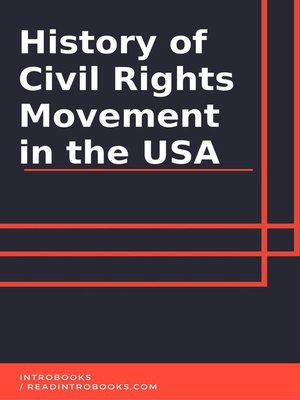
Sign up to save your library
With an OverDrive account, you can save your favorite libraries for at-a-glance information about availability. Find out more about OverDrive accounts.
Find this title in Libby, the library reading app by OverDrive.



Search for a digital library with this title
Title found at these libraries:
| Loading... |
Long before the particular civil rights movement in the United
States of America of the time of 1950s & 1960s had started
making proper headlines, the response of the black community
towards oppression as well as racial inequality was highly under
its way. Definitely, as the failed emancipation's promise in the
latter half of the 19
th century had given rise to the case of
Jim Crow which was viewed as a series of customs and laws
that were responsible for segregation and disfranchising of the
black community – it was also responsible for compelling a
group of individuals towards launching the efforts for asserting
their respective constitutional rights and for improving their
given standing in the community. Towards the turning of the
century, for instance, the outspoken leader Ida B. Wells had
grappled with the most major leading issues of the time: the
lynching of the people belonging to the black community.
Through a series of highly analyzed orchestrated attack on the
journalist, Wells had almost brought the given form of violence
that tended to be racial singlehandedly –this represented as the
major trenchant symbolism of the supremacy of the whites –to
the headlines of the consciousness of the nation. However, the
others were still mobilizing the overall creation of the leading
organizations that would be shaping and supporting the fights
& movements for the given civil rights. Under this scenario,
Marcus Garvey was responsible for forming the Universal
Negro Improvement Association during the time of 1917 for the
aim of promoting his contention with respect to the fact that
the black community should be working towards
self-determination: the idea that was responsible for prefiguring
the overall power movement of the black community during the
time of the 1960s. Similarly, during the time of the 1905, the
man named W.E.B Du Bois and several other leaders had
resulted into the formation of the famous Niagara Movement
for addressing the black grievances. This had led to the
immensely influential and reputed NAACP (National Association
for the Advancement of the Colored People) along with the
legal assaulting of the given discrimination.
As the early times of the black community and activists were
seeking a similar present –a highly equitable society –the
respective goals & means were not completely unified, under
some cases, their respective efforts towards eliminating the given
racial barriers had been in direct opposition to the other. For
instance, Booker T. Washington had promoted vocational
training along with economic independence as the means of
proper tactical response, in portions, towards the southern
economy in the field of agriculture. However, the pragmatic
approach adopted by Washington was under fire soon as
claimed to some predominantly white group during the time of
1895 that under all the things that were purely social, the
individuals could be separate as our fingers, however, they were
all one just like the hand for the things that involved mutual
progress. The critics of Washington, most importantly W.E.B.
Du Bois, had denounced the given promotion of segregation as
well as the willingness of foregoing the political power of the
black community. In comparison to Washington, W.E.B. Du Bois
who was a Harvard-educated person of intellect had advocated
the complete transformation of the cultural as well as the
political life of the...






